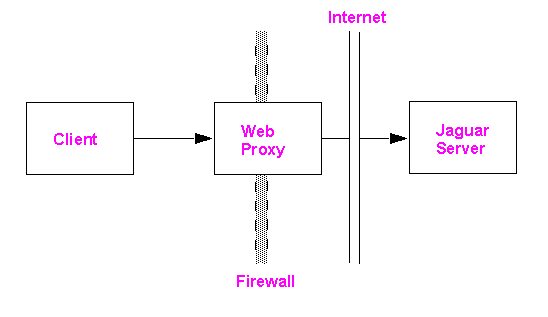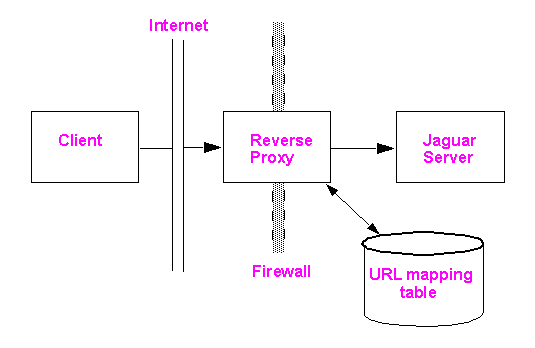

Chapter 14 Using SSL and Proxy Connections in Java Clients
Proxy servers are typically used to constrain and secure connections from an organization's computers to sites that require connecting across the Internet. To enhance security, some network configurations require all Internet connections to go through a proxy server, including IIOP connections to a Jaguar server.
Jaguar supports two types of proxy servers for Java clients, Web proxies and reverse proxies.
Web proxies typically act as a gateway for outgoing connections from a group of workstations. Web proxies can be used to enhance network security, for example, a proxy may constrain which servers clients can connect to and which protocols may be used, and log outgoing connections. Web proxies may also be used to improve network performance, by caching the results of frequently executed Web requests. Web proxies are also referred to as HTTP-connect-based proxies. Figure 14-1 illustrates how clients connect to servers through a Web proxy:

Clients connect to Jaguar through a Web proxy as follows:
Java applets can use the built-in proxy configuration provided by Web browsers such as Netscape Navigator. See your Web browser's documentation for information on configuring proxy addresses. For applets running in a Web browser, HTTP and HTTPS tunnelled IIOP connections will automatically use the browser's proxy connection settings. HTTP-tunnelled IIOP connections go through the browser's configured HTTP proxy. HTTPS-tunnelled IIOP connections go through the browser's configured secure proxy.
Java applications must specify the Web proxy address by setting
the com.sybase.CORBA.WebProxyPort
and com.sybase.CORBA.WebProxyHost
properties
described below.
Table 14-2 describes the Java client properties that apply to Java applets or applications that connect through a Web proxy. You must set these properties in addition to any properties that you would set to connect directly to the Jaguar server.
Reverse proxies typically act as a gateway for incoming connections to an organization's network servers, preventing direct connections from clients outside the firewall to servers inside the firewall. The reverse proxy can enhance security, by restricting protocols and logging connection activity. Reverse proxies may also act as caches to respond to common requests. In some cases, multiple reverse proxies may be deployed to cache results from one server, as a form of load balancing. Figure 14-2 shows how clients connect through a reverse proxy.

Clients connect to Jaguar through a reverse proxy as follows:
GET /host/port/HIOP/1.0/...
For use with Jaguar, you must configure your reverse proxy server's URL mapping table to recognize the Jaguar server addresses embedded in the HTTP requests sent by the client runtime. For each Jaguar server that clients may connect to through the server, configure a mapping for the following URL prefix:
GET /host/port/HIOP/1.0/
Where host is the target Jaguar listener host name, and port is the target Jaguar listener port number. For each Jaguar server that you deploy behind the reverse proxy, add a mapping for each IIOP, IIOPS, and Message Service listener address. If you deploy a cluster of Jaguar servers behind a reverse proxy, add mappings for each server in the cluster.
To connect through a reverse-proxy server, you can set the properties in Table 14-3. You must set these properties in addition to any properties that you would set to connect directly to the Jaguar server.
CORBA property |
EJB property |
To indicate |
|---|---|---|
com.sybase.CORBA. |
com.sybase.ejb. |
Specifies the machine name or the IP address of the reverse-proxy server. |
com.sybase.CORBA. |
com.sybase.ejb. |
Specifies the port number of the reverse-proxy server, typically 80 for HTTP-tunnelled connections or 443 for SSL (HTTPS-tunnelled) connections. |
com.sybase.CORBA. |
com.sybase.ejb. |
Set this property to true if the reverse-proxy server requires HTTP-tunneled connections. If you do not set this property, connections still go through, but only after the client ORB first tries to open an IIOP connection. Setting the property eliminates the overhead that is incurred by trying plain IIOP each time a connection is made. |
com.sybase.CORBA. |
com.sybase.ejb. |
In Java applets, set this property to true if the connection to the reverse proxy must use SSL (HTTPS) tunnelling, but the connection from the proxy to the Jaguar server does not use SSL tunnelling. |
com.sybase.CORBA. |
com.sybase.ejb. |
In Java applications that connect to a proxy using SSL (HTTPS) tunnelling, set the QOP to a security level that matches the level supported by the reverse-proxy server. For instructions on setting this property, see "SSL properties". If the connection to the proxy server requires SSL, but the connection from the proxy does not, do not set the QOP; instead, set the com.sybase.CORBA.forceSSL property to true. Do not set QOP in Java applets that use SSL. Instead, code the applet to connect to a listener that supports the required security level. See "Using SSL in Java applets" for more information. |
com.sybase.CORBA. |
com.sybase.ejb. |
In Java applets, set this property to true to enable connections to a reverse-proxy server. You must also configure your applet to download through the reverse-proxy server itself. The default is false. This property is ignored if the client is not a Java applet, or has not initialized the Java ORB with the ORB.init method that takes an Applet parameter. When automatic proxy is enabled, the ORB uses the applet's download address as the reverse-proxy server address. If the port number is 443, SSL (HTTPS tunnelling) is used; otherwise, HTTP tunnelling is used. |
| Copyright © 2000 Sybase, Inc. All rights reserved. |

| |